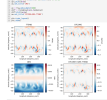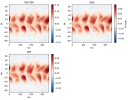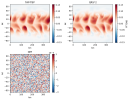Hi all,
I'm getting started with CESM2.1.5 and running a held-suarez test with the default settings (Eulerian spectral-transform dynamical core, T42z30_T42_mg17). I'm trying to understand the temperature tendency terms. Should I expect the total temperature tendency (given by TTEND) to be the sum of dycore tendency (DTCORE), diffusion (DTH) and relaxation (QRS)? I've done a quick check but these terms do not sum to the total tendency. Maybe I’m misunderstanding the tendency budget. Could someone help me with this?
Additionally, is my understanding correct that dycore tendency is related to advection?
Thanks!
I'm getting started with CESM2.1.5 and running a held-suarez test with the default settings (Eulerian spectral-transform dynamical core, T42z30_T42_mg17). I'm trying to understand the temperature tendency terms. Should I expect the total temperature tendency (given by TTEND) to be the sum of dycore tendency (DTCORE), diffusion (DTH) and relaxation (QRS)? I've done a quick check but these terms do not sum to the total tendency. Maybe I’m misunderstanding the tendency budget. Could someone help me with this?
Additionally, is my understanding correct that dycore tendency is related to advection?
Thanks!



